Crux is a constellation centered on four stars in the southern sky, in a bright portion of the Milky Way. It is among the most easily distinguishable constellations since its asterism stars have an apparent magnitude brighter than +2.8.
Key Facts & Summary
- The constellation of Crux is the smallest out of all the 88 modern constellations, stretching for around 68 square degrees in the sky.
- The name, Crux, comes from Latin and it translates to “Cross” – since the constellation is dominated by a cross-shaped or kite-shaped-like asterism commonly known as the Southern Cross.
- There are no Messier objects in the constellation of Crux.
- Though Crux is the smallest constellation in the sky, it contains numerous interesting stars (apart from the ones that make up the Southern Cross asterism), and other deep-sky objects such as Coalsack Nebula or the Jewel Box Cluster.
- Currently, there are only two stars in Crux that have been discovered to host planets.
- The five main stars of Crux that comprise the Southern Cross asterism are Acrux, Mimosa, Gacrux, Imai, and Ginan.
- The brightest star in the constellation of Crux is Acrux, which is a triple star system having a visual magnitude of 0.8.
- Within the borders of Crux, there are around 49 stars that are brighter or equal to apparent magnitude 6.5.
- Unusually, a total of 15 of the 23 brightest stars in Crux are spectrally blue-white B-type stars.
- Among the five main bright stars, Imai, and probably Acrux and Mimosa, are likely co-moving B-type members of the Scorpius-Centaurus Association, the nearest OB association to the Sun.
- An OB association is a very loose star cluster, containing several stars that share a common origin but have gravitationally unbound and are still moving together through space.
- The constellation of Crux also contains many variable stars, among them, four Cepheid variable stars reach naked-eye visibility.
Though Crux is the smallest constellation in the sky, it is among the best-known constellations in the southern hemisphere. It is easily recognizable due to its cross-shaped asterism, the Southern Cross, formed by its five brightest stars – Acrux, Gacrux, Imai, Mimosa, and Ginan.
The constellation of Crux is associated with several stories and it figures prominently in different mythologies in the southern hemisphere. It holds special importance in Australia and New Zealand, where it is circumpolar and can be seen throughout the year.
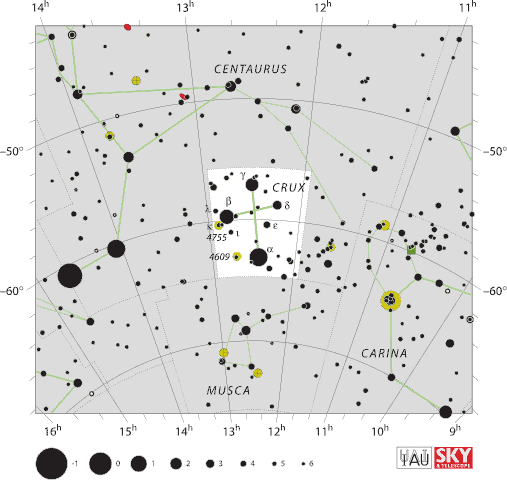
Crux means “Cross” in Latin. The ancient Greeks considered Crux to be part of the constellation of Centaurus. Though its stars were charted on most celestial globes, it was not until 1679 that Crux became a constellation in its own right.
The French astronomer, Augustin Royer, formally separated Crux from Centaurus. Some historians credit the Dutch astronomer Petrus Plancius for creating the constellation in 1613, as it was published by Jakob Bartsch in 1624.
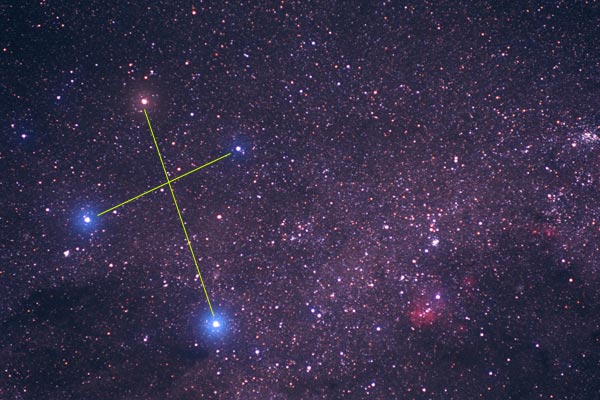
Location
The constellation of Crux is the smallest out of the 88 modern constellations. Crux spreads out for around 68 square degrees in the sky.
Crux is not visible north of “20o in the northern hemisphere, and it is circumpolar south of 34oS, this means that it never sets below the horizon. On the celestial sphere, Crux is exactly opposite the constellation Cassiopeia.
- Right Ascension: 12.6h
- Declination: -60o
- Visible: +20o and -90o
- Best viewed: at 21:00 – 9 p.m. during May
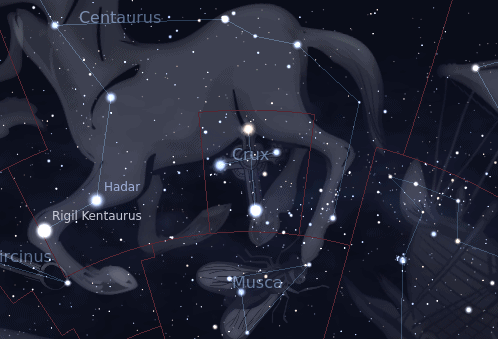
Crux is located in the third quadrant of the southern hemisphere (SQ3). The neighboring constellations around Crux are Centaurus and Musca.
Crux belongs to the Hercules family of constellations, along with Aquila, Ara, Centaurus, Corona Australis, Corvus, Crater, Cygnus, Hercules, Hydra, Lupus, Lyra, Ophiuchus, Sagitta, Scutum, Sextans, Serpens, Triangulum Australe, and Vulpecula.
Notable Stars
The brightest stars in Crux are the Southern Cross asterism stars Acrux, Gacrux, Imai, Mimosa, and Ginan. The brightest star in Crux is Acrux, having an apparent magnitude of 0.76.
The Southern Cross asterism carries cultural significance in several countries in the southern hemisphere.
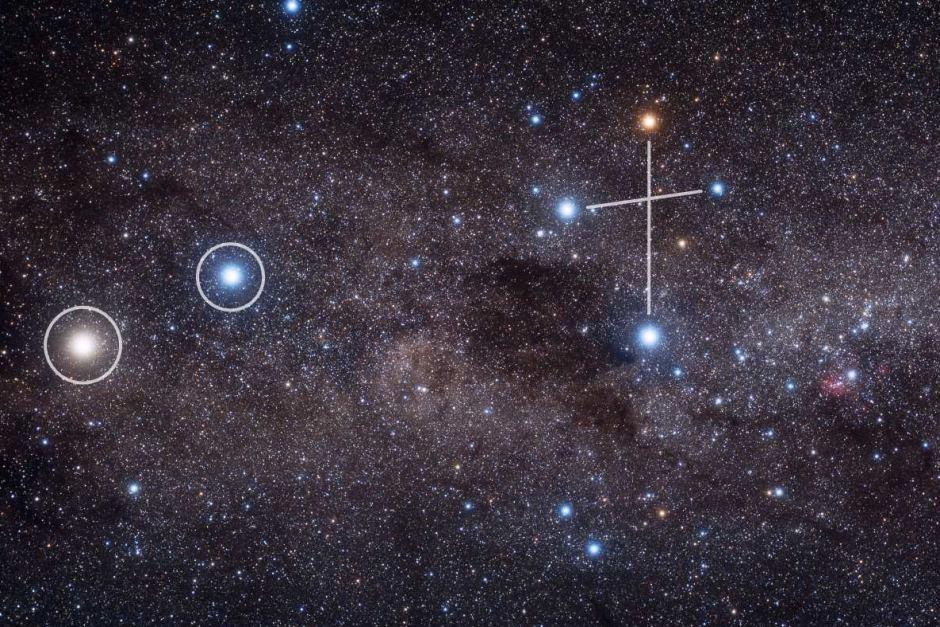
Acrux
Acrux, also designated as Alpha Crucis, is the brightest star in the constellation of Crux, and the 13th brightness star in the night sky, however, it can also be the 12th due to its variability in brightness.
Acrux is a multiple star system, with the primary star being a blue-white subgiant star located at around 321 light-years away from the Sun. The secondary star is a blue dwarf.
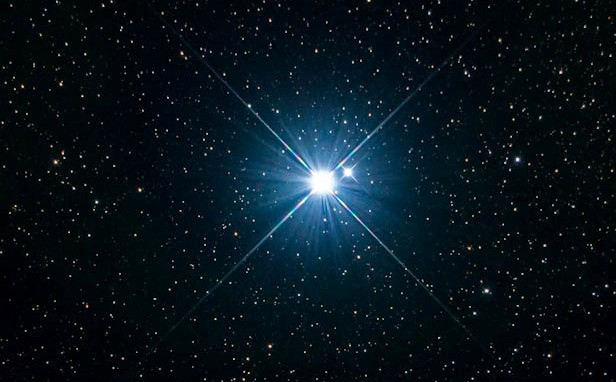
Acrux is 25,000 times brighter than our Sun, having 1780% of our Sun’s mass. The secondary star, Acrux B, has 1552% of our Sun’s mass, and it is 16,000 times brighter than our Sun.
Acrux A is several times bigger than our Sun, having 780% of our Sun’s radius, while Acrux B has 540% of our Sun’s radius. Both stars are several times hotter than our Sun, having surface temperatures of 24,000 K and 28,000 K, respectively.
Gacrux
Gacrux, designated as Gamma Crucis, is the nearest M-class giant star to the Sun, located at around 88.6 light-years away. Gacrux is the third brightest star in the constellation of Crux, and the 25th brightest star in the night sky.
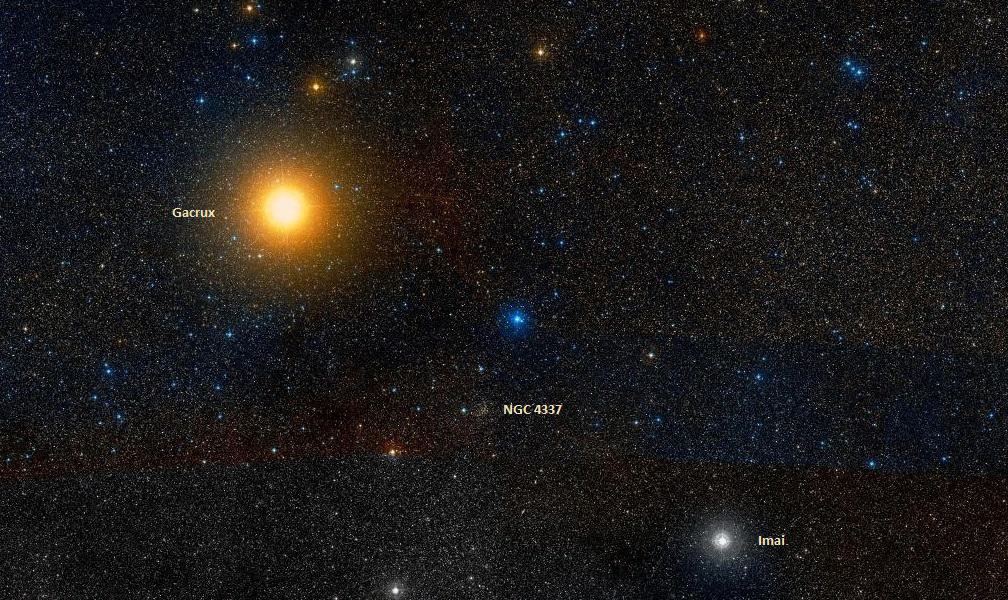
Gacrux is around 820 times brighter than our Sun, having 150% of our Sun’s mass, and 840% of its radius. Gacrux is the brightest star of its class in the sky, and the nearest red giant to the solar system. Gacrux has an apparent magnitude of +1.64.
Imai
Imai, designated as Delta Crucis, is a blue-white subgiant star with an apparent magnitude of 2.79, it is the fourth brightest star in the constellation of Crux.
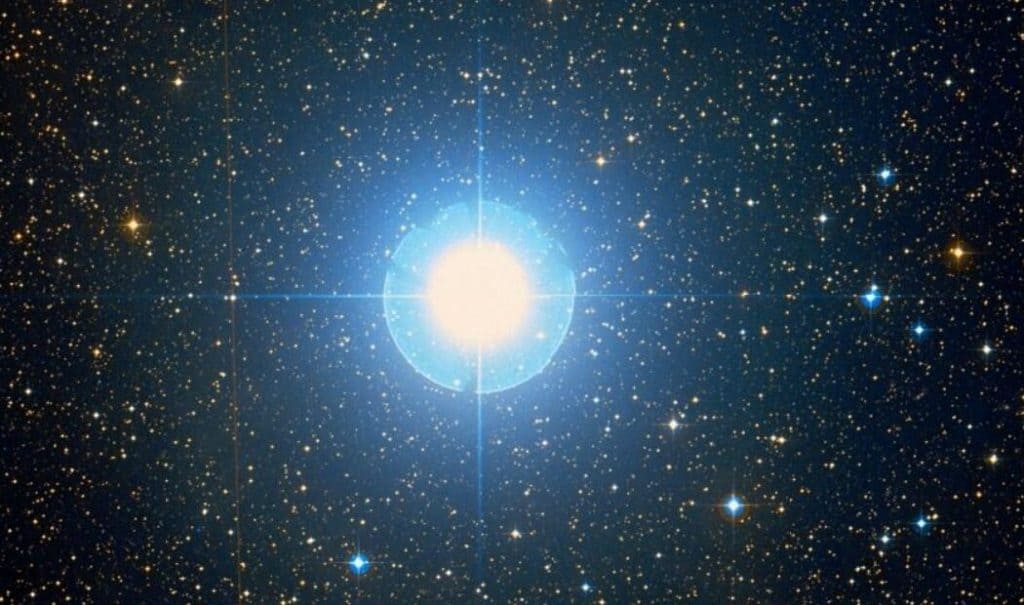
Imai is located at around 345 light-years away from us. It is 10,000 times brighter than our Sun, having 890% of its mass, and 800% of its radius.
Imai has an effective temperature of around 22,570 K. It is a candidate Beta Cephei variable, exhibiting subtle changes in brightness over 3.7 hours. Imai is a fast-spinning star with a rotational velocity of around 210 km / 130.4 mi per second.
Mimosa
Mimosa, designated as Beta Crucis, is the second-brightest star in the constellation of Crux, and the 20th brightest star in the night sky. Mimosa has an apparent magnitude of 1.25.
This star is a binary star, and a third component star is also suspected of being part of the system. Mimosa is located at around 280 light-years away from Earth.
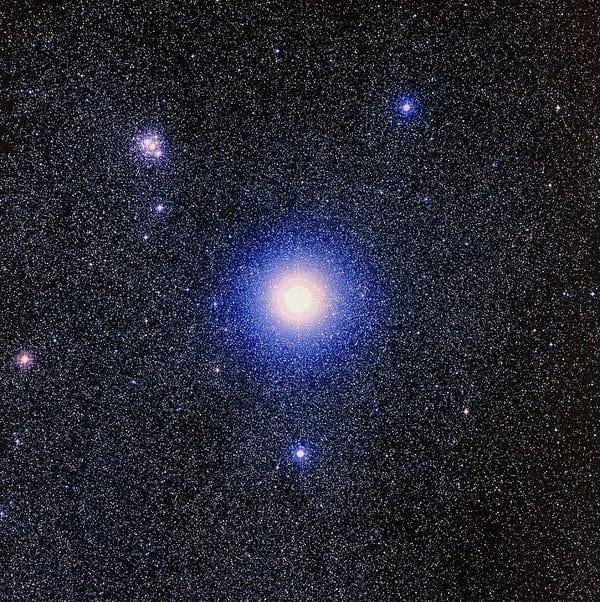
Mimosa is 34,000 times brighter than our Sun, having 1600% of its mass, and 840% of its radius. It is quite a young star, having an estimated age between 8 to 11 million years. Acrux and Mimosa are known as the Southern Pointers, since they, together with Gacrux, are used to find the South Celestial Pole.
Ginan
Ginan, designated as Epsilon Crucis, is an orange-hued star located at around 230 light-years away from us. Ginan has an apparent magnitude of 3.58, being the fifth brightest star in the constellation of Crux.
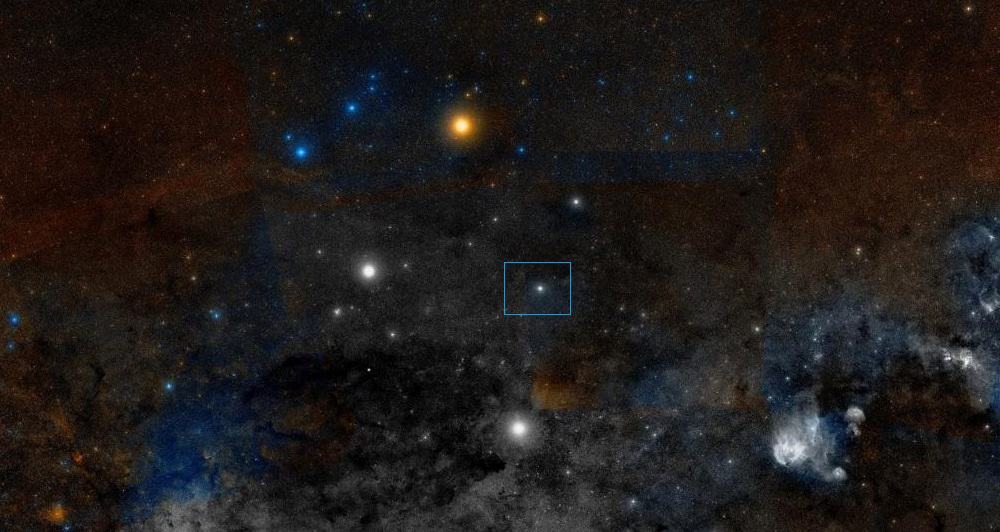
Ginan is 302 times brighter than our Sun, having 152% of its mass, and around 2841% of its radius. It is evolving away from the main sequence and thus it will continue to expand.
Other stars
Apart from the five stars that make up the Southern Cross asterism, the constellation of Crux also hosts many variable stars, among them, four Cepheid variable stars that reach naked-eye visibility.
Zeta Crucis
Zeta Crucis is a binary star system, visible to the naked eye, having an apparent magnitude of 4.04. Zeta Crucis is located at around 360 light-years away from us.
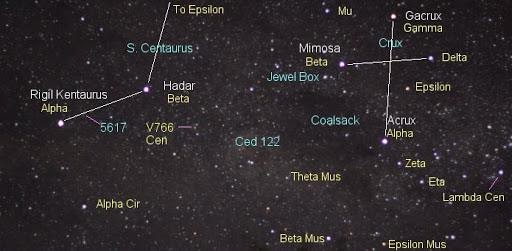
The primary star is a B-type main-sequence star that is 737 times brighter than our Sun, having 640% of its mass. Zeta Crucis is cooler than our Sun, and it is a member of the Lower Centaurus Crux subgroup of the Scorpius-Centaurus Association.
Theta Crucis
Theta Crucis is a spectroscopic binary star situated at around 850 light-years away from us, having an apparent magnitude of 4.7.
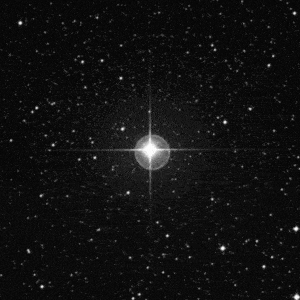
Theta Crucis is recognized as a system consisting of a B-type main-sequence blueish-white star, with one of the members being a Cephei-variable star. The primary star is 809 times brighter than our Sun.
Lambda Crucis
Lambda Crucis is a suspected Beta-Cephei variable star, situated at around 384 light-years away from us, and has an apparent magnitude of 4.62.
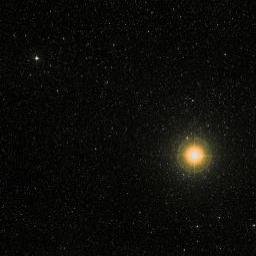
Lambda Crucis is near the constellation border with Centaurus. This star is 790 times brighter than our Sun, having 300% of its radius, and around 500% of its mass.
Iota Crucis
Iota Crucis is a wide double star, appearing as an orange-hued point of light with an apparent magnitude of 4.69. It is located at around 125 light-years away.
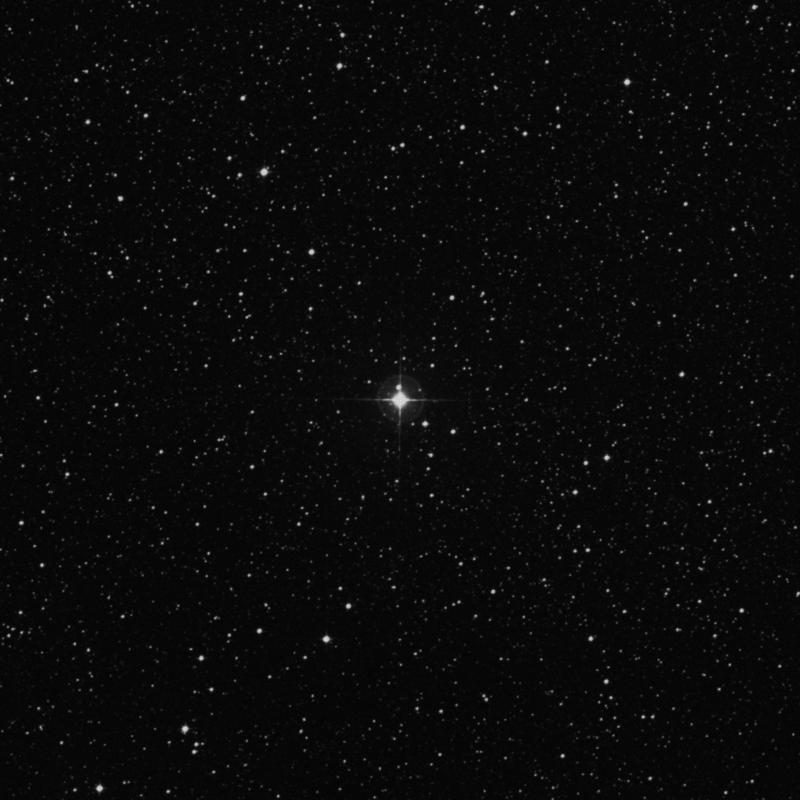
Iota Crucis is an aging giant star, 24 times brighter than our Sun, and having 726% of its radius, and a surface temperature of around 4,824 K.
BZ Crucis
BZ Crucis is a Be star classified as a B1IVe class star. It is a subgiant showing emission lines in its spectrum. Also classified as a Gamma Cassiopeiae variable star, BZ Crucis has a circumstellar disk around its equator.
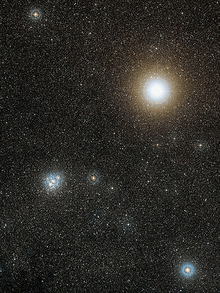
BZ Crucis is also an X-ray source, having an apparent magnitude of 5.3, and it is around 1,000 light-years away from us, situated behind the Coalsack Nebula.
NGC 4349-127
NGC 4349-127 is a possible red giant star, located at around 7,097 light-years away from us. It is a member of the open cluster NGC 4349.
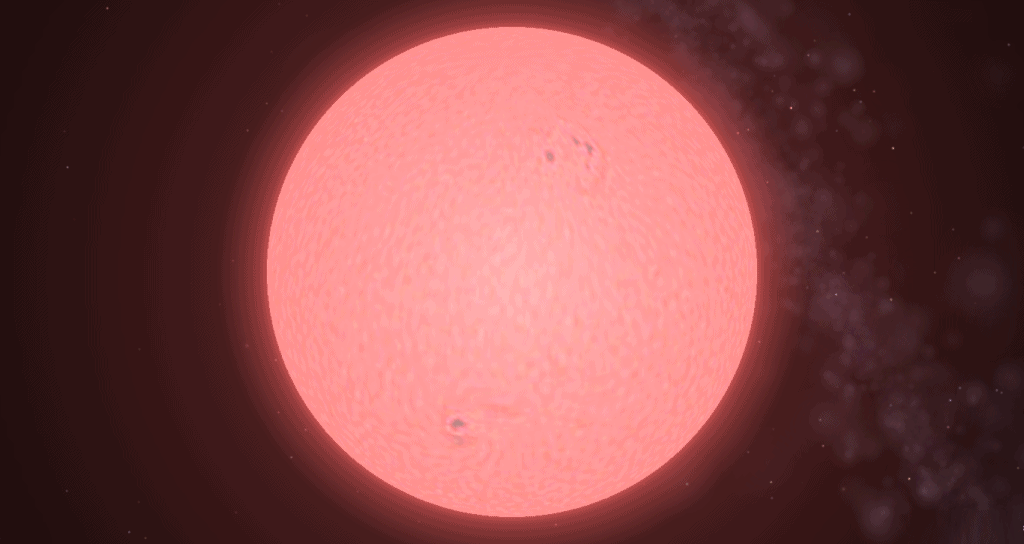
This star has an apparent magnitude of +7.4. It has around 390% of our Sun’s mass, and it is very young, only 200 million years old. NGC 4349-127 has a brown dwarf that is around 2000% more massive than Jupiter, orbiting around it.
Deep-Sky Objects
The constellation of Crux is quite devoid of deep-sky objects, however, the Coalsack Nebula, and the Jewel Box open star cluster are worth observing.
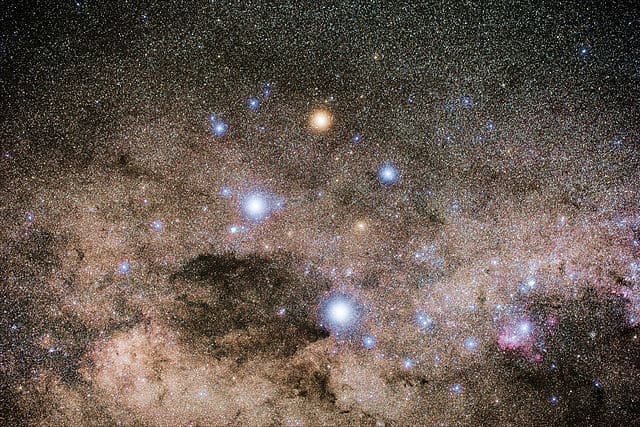
Coalsack Nebula
The Coalsack Nebula, also known as the Southern Coalsack, or designated as Caldwell 99, is the most prominent dark nebula in the sky, being visible to the naked eye as a dark patch obscuring a section of the Milky Way.
More accurately, it obscures the stars as they cross their southernmost region of the sky, east of Acrux, which is the brightest southern pointer star of the southern cross asterism.
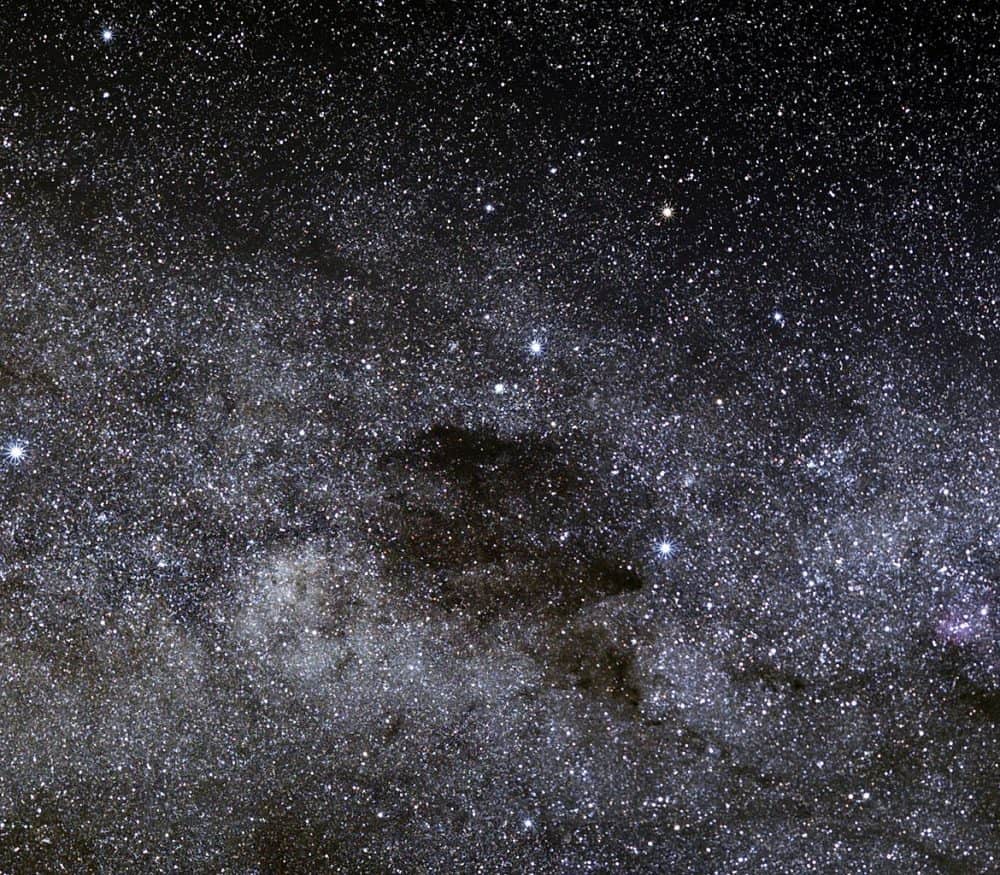
The Coalsack Nebula stretches from 7o by 5o, having a radius between 30 to 35 light-years, and overlapping somewhat into the neighboring constellations of Centaurus and Musca. The nebula has also been called the Black Magellanic Cloud – in opposition to the Magellanic Clouds.
The Coalsack Nebula is situated at around 600 light-years away from us, however, it was known since pre-historic times in the southern hemisphere.
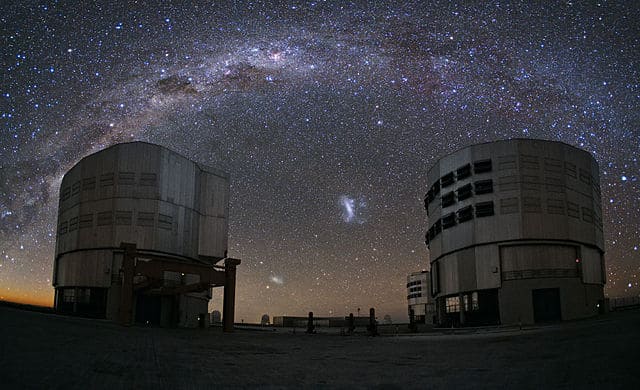
The Jewel Box Cluster
The Jewel Box Cluster, also known as Kappa Crucis Cluster, NGC 4755, or Caldwell 94, is an open cluster located at around 1.0o southeast of the star Mimosa, being around 6,440 light-years away from us.
The Jewel Box Cluster has an estimated age of around 14 million years, being among the youngest clusters ever discovered, having around 100 stars. The total integrated magnitude of the Jewel Box cluster is 4.2.
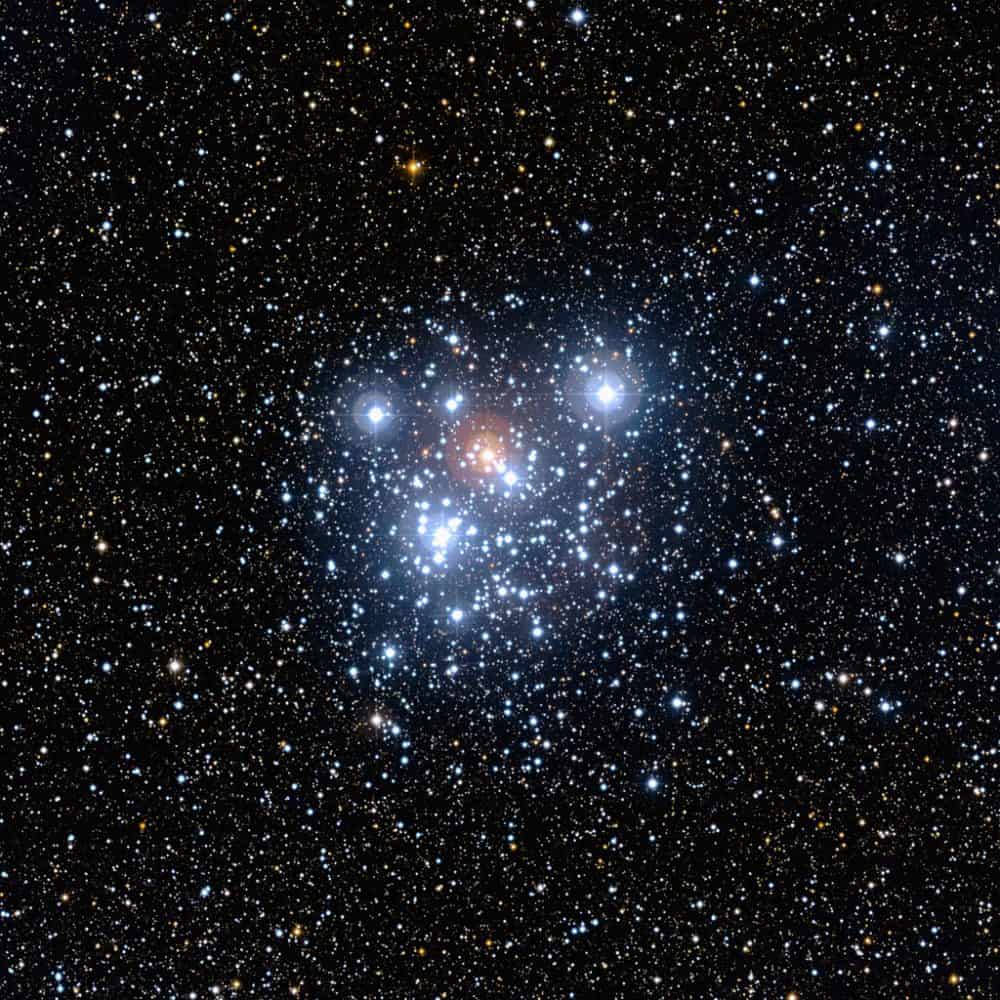
This cluster was discovered in 1751 by French astronomer Nicolaus Louis de Lacaille on his trip to South Africa. The cluster can only be seen from the southern hemisphere.
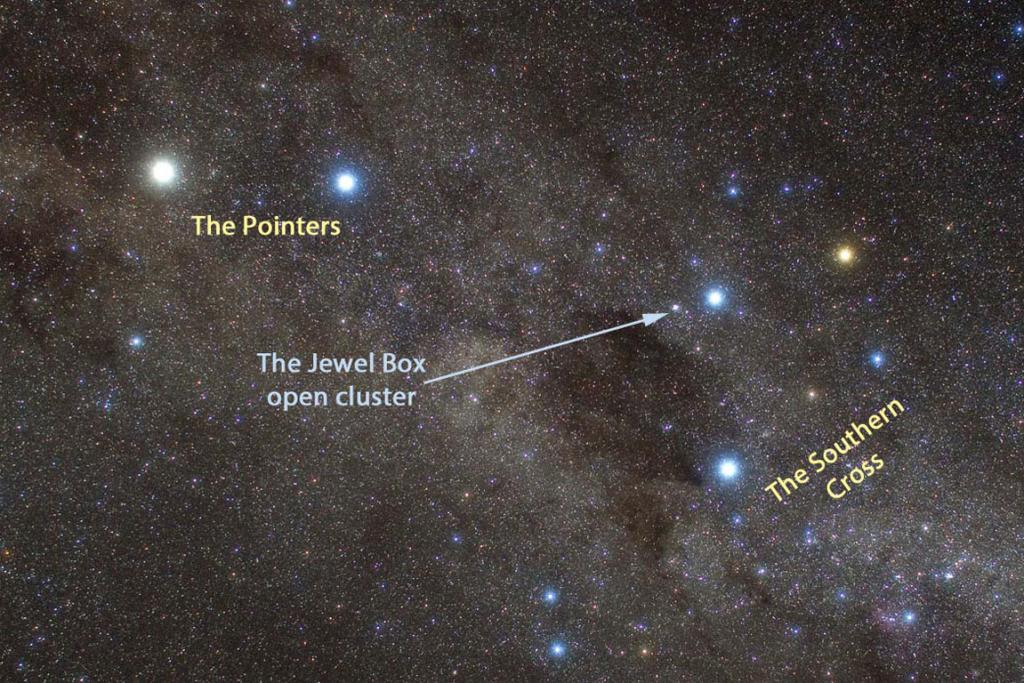
Mythology
The constellation of Crux is well-known in many southern cultures. The ancient Greeks saw Crux before its stars dropped below the horizon, for Europe, and most of the northern hemisphere.
Some Christians saw significance in this, and thus linked the disappearance of the celestial cross from the sky, with the crucifixion of Christ.
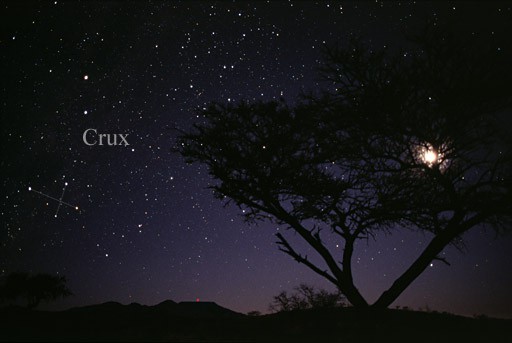
Did you know?
- In the year 400 AD, the constellation of Crux was invisible for most of Europe, and thus the Europeans did not rediscover Crux until the great naval expeditions of the late 15th and early 16th centuries.
- A stone image of the constellation of Crux has been found in Machu Picchu in Peru. The Inca knew the constellation as Chakana – “ the stair “ – the Maori called Crux the Punga – “ the anchor “.
- The Southern Cross asterism is represented on the Australian flag, while its stars are featured on the flag of Brazil, where the asterism is known as Cruzeiro.
- The Southern Cross asterism is also known as Cruzeiro do Sul, and it is mentioned in the Brazilian national anthem and used to be the name of the currency between 1942 and 1986, 1990 and 1994.
- In Australian aboriginal astronomy, the Coalsack Nebula represented the head of the emu in the sky. Among the Wardaman people, it is said to be the head and shoulders of a law-man watching the people to ensure they do not break traditional law.
- In Inca astronomy, the Coalsack Nebula was called Yutu, meaning a partridge-like southern bird or Tinamou.
Sources:
Image Sources:
- https://upload.wikimedia.org/wikipedia/commons/thumb/c/cf/Crux_IAU.svg/507px-Crux_IAU.svg.png
- https://earthsky.org/upl/2009/01/crux_Christopher_J_Picking.jpeg
- https://in-the-sky.org/images/constellations/con_CRU_000.png
- https://www.abc.net.au/news/image/9779624-3x2-940x627.jpg
- https://www.astronomytrek.com/wp-content/uploads/2017/05/Acrux.jpg
- https://nineplanets.org/wp-content/uploads/2020/01/Gacrux-Imai-and-NGC.jpg
- https://www.star-facts.com/wp-content/uploads/2020/07/Mirzam-1050x620.jpg?189db0&189db0
- https://nineplanets.org/wp-content/uploads/2020/01/optical-image-of-the-star-mimosa-or-beta-crucis-celestial-image-co.jpg
- https://www.star-facts.com/wp-content/uploads/2019/10/Ginan.jpg?189db0&189db0
- https://lh3.googleusercontent.com/proxy/HD86k52Zd82fNK7en5oj2lLWoKBXw76UIn4UWopnnKx9Ad8JQ227pxwuHlX4uc7njCp-d-bHuvkjRfxbjkqZEkjvDn513KyS
- https://sandandstars.co.za/wp-content/uploads/2016/08/Delta-Crucis-300x300.gif
- https://mw1.google.com/mw-planetary/sky/skytiles_v1/59_90_7.jpg
- https://theskylive.com/sky/stars/star-images/48/4842_800.jpg
- https://upload.wikimedia.org/wikipedia/commons/thumb/b/b5/Trishanku_Shir_%28Beta_Crucis%29.png/220px-Trishanku_Shir_%28Beta_Crucis%29.png
- https://upload.wikimedia.org/wikipedia/commons/f/f0/NGC_4349-127_star_in_Celestia.png
- https://upload.wikimedia.org/wikipedia/commons/thumb/c/cc/Deep_Crux_wide_field_with_fog.jpg/640px-Deep_Crux_wide_field_with_fog.jpg
- https://www.constellation-guide.com/wp-content/uploads/2015/10/Coalsack-Nebula.jpg
- https://upload.wikimedia.org/wikipedia/commons/thumb/3/3d/An_Emu_in_the_Sky_over_Paranal.jpg/640px-An_Emu_in_the_Sky_over_Paranal.jpg
- https://www.constellation-guide.com/wp-content/uploads/2015/07/Jewel-Box.jpg
- https://static2.stuff.co.nz/1366877945/955/8597955.jpg
- https://www.ouruniverseforkids.com/wp-content/uploads/2018/06/Crux.jpg
